- About Us
- Our Work
- Tree Info
- Get Involved
- Blog
- Support Us
Urban trees combat climate change, enhance public health, and contribute to vibrant, sustainable communities. Additionally, they represent a water-efficient investment; a well-managed urban forest saves more water than it consumes!
1. Know your trees, know their needs.
Different trees have different water and care requirements. To determine how much and how often your tree needs water, consider:
Besides proper watering, the best thing you can do for your tree is to apply mulch over its root system.
 Properly applied, mulch:
Properly applied, mulch:
Mulching Tips:
Use organic matter such as wood chips, with or without leaf matter. Trees actually prefer wood chip mulch and the “duff” created by their own leaves.
Apply mulch layer 3-5 inches deep (or 1 inch deep if using spray irrigation), extending at least as far as the drip line.
Say no to mulch volcanoes! Mulch should have a “donut” distribution, not a “volcano” shape. Mulch should be a few inches away from the base of the tree; too much moisture around the trunk can lead to decay.
If weeds persist, place a layer of newspaper, cardboard, or a biodegradable weed cloth fabric underneath the mulch.
Replenish the mulch layer every spring just as the natural rains taper off; you will capture nature’s water, reducing the amount of irrigation needed in the dry months.
3. Remove your lawn - but help your trees transition!
It may look tidy, but traditional turf can suck up a lot of water without offering much in the way of environmental benefits.
 Remove your lawn or let it go golden.
Remove your lawn or let it go golden.
Since more than half of outdoor water is used on lawns, removing your lawn, letting it go golden, or substituting drought-tolerant native grasses can help lower your landscape water use. As an added bonus, many cities (as well as Santa Clara Valley Water District) offer rebates for lawn removal.
But help your trees transition!
Trees surrounded by lawn develop shallow roots and are accustomed to frequent shallow watering. They can adapt, but will need time to adjust to a less frequent, deeper watering pattern. Use mulch liberally to help with this transition. Consider installing a drip system.
More info:
4. Plant drought-tolerant trees
Planting new trees to replenish the urban forest is more important than ever.
To prepare for a hotter, drier future, however, it’s important to plant the right trees.
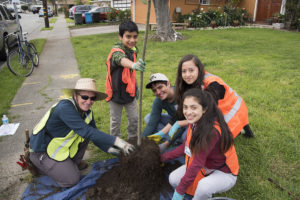 Choose climate-appropriate, drought-tolerant species. Visit the Canopy tree library for help choosing the right tree for your site.
Choose climate-appropriate, drought-tolerant species. Visit the Canopy tree library for help choosing the right tree for your site.
Match the tree to its location. A properly sited tree will be healthier and longer-lived. Consider factors including: existing access to water, soil type, shade, and overhead wires.
More info:
1. How do I know if my tree needs water?
Two key ways to find out if your tree needs water: (1) check soil moisture and (2) check for signs of drought stress.

Checking soil from a moisture probe
1. Assess soil moisture: Probe the soil to a depth of 12 inches at several locations around the tree’s drip line. You can use a moisture probe if you have one (or contact Canopy to borrow one!), otherwise use a shovel to dig down into the soil. Driving a long screwdriver into the ground can work, too.
Damp soil 6-12 inches below the surface is good; it means your tree roots have access to the moisture they need. Soggy or saturated soil, however, means your tree is getting too much water. This reduces oxygen in the soil and can kill tree roots. Dry, crumbly soil means it’s time to water!
2. Check for signs of drought stress: If your tree is drought-stressed, you may notice a sparse canopy, browning foliage, or early leaf drop. Wilting leaves can also indicate drought-stress, although many trees do not exhibit this symptom until it’s too late to save them.
Note that many of these symptoms can also be signs of over-watering — when in doubt, check the soil! Or consult a certified arborist.
2. How often should I water my tree? How much water should I use?
For a detailed answer, check out Canopy’s tree watering guidelines.
A few general rules of thumb:
Water young trees every week or every two weeks. Use about 10-15 gallons for each watering. It’s especially important to water newly planted trees to help them recover from the stress of a transplant.
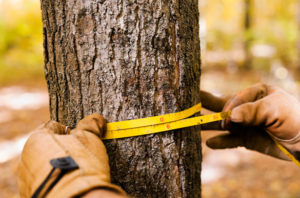
Measure your tree’s diameter at breast height (DBH) to calculate how much water it needs.
Water mature trees once a month or every other month. Use 10-15 gallons of water per inch of trunk diameter, measured at “breast height” (defined as 4.5 feet off the ground). For example, a tree with a 10” trunk diameter at breast height would need 100 – 150 gallons of water (about the same as 4 or 5 loads of laundry). Don’t forget to apply water slowly so it has time to soak into the ground.
Water more frequently during major stressors, like extreme heat (over 90 degrees F) or major root loss (e.g. during construction).
Water less often during rainy periods or when temperatures drop.
Under normal circumstances, mature native oak trees should not be watered during the summer, since the combination of heat and moisture puts trees at risk of fungal infection (e.g. “root rot”) or mold. However, even native oaks may need supplemental water during prolonged periods of drought or other major stressors.
Tip: Water during morning or evening to reduce water loss
The best time to water is either early in the morning or in the evening. These times are cooler, so less water is lost to evaporation.
3. What's the most efficient method for watering trees?
Not all watering methods are created equal. By applying water where and when your tree needs it the most, you’ll help your tree thrive while using limited water.
Water gradually and deeply. Apply water slowly and evenly to the tree’s root zone (see diagram), saturating the soil to a depth of 12-18 inches. If applied slowly, water will soak into even hard clay soils. If you have hard clay soils, consider breaking up the top layer of soil to help water penetrate more quickly. Allow soil to dry out between waterings.
Water-efficient methods:
Hand-watering: A good choice for establishing young drought-tolerant trees. Create a soil basin within the tree’s drip line and fill with water from a hose or bucket. Allow water to soak in, and repeat two times. See Caring for Young Trees for further instructions on basin watering.
Drip irrigation: Another efficient method is to install a drip irrigation system, or convert sprinkler systems from spray to drip. You can also use a soaker hose for a cost-efficient alternative. Like hand-watering, these methods apply water at a slow rate, directly where it’s needed near the tree roots.
Watering methods to avoid:
Sprinklers and spray irrigation apply water at a fast rate, resulting in water loss due to runoff and evaporation.
Lawn irrigation does not water trees successfully. It generally reaches only the first few inches of soil, encouraging trees to form weak “surface roots.”
4. Am I supposed to water city-owned street trees near my home?
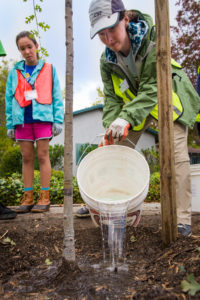
Please do! For cities in our area (including Palo Alto and Mountain View), it is typically the residents’ responsibility to water street trees in front of their home.
This includes young and newly planted trees (which need regular watering to survive during their first few years), as well as mature trees, some of which need supplemental water during prolonged dry spells.
If you want to be a tree care star, you can also weed and apply mulch to the area around your street tree.
However, NEVER PRUNE street trees. If your city-owned street tree needs pruning or other maintenance beyond the basics, contact your city.
5. Should I fertilize my tree during drought?
No, do not fertilize trees during prolonged dry spells. Under normal circumstances, most non-fruit trees do not require fertilization anyway. During drought conditions, it’s especially important to avoid fertilizing, since it promotes a “growth spurt” that the tree cannot sustain in water-scarce conditions.
Note that fruit trees are a special case and may have different requirements.
6. Should I really plant new trees during drought?
Yes! It may seem counter-intuitive, but planting trees is even more important during a drought.
Here’s why:
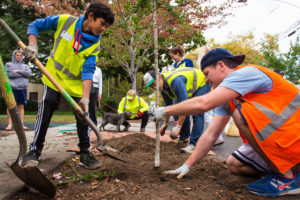
Trees will help neighborhoods stay cool in a hotter, drier future.
Scientists predict a warmer, drier future for California. Trees provide cooling shade that saves energy, protects infrastructure, and reduces urban heat islands. In a hotter, drier environment, we need the benefits of a healthy urban forest more than ever.
Trees help us conserve water. Tree roots and leaves play a critical role in capturing any rainwater we do receive, reducing runoff and increasing water storage in the soil.
Some urban trees will succumb to drought stress. To renew the urban forest, it’s important to plant drought-tolerant, climate-appropriate species that can withstand future drought conditions.
Note that, in our region, the ideal time to plant trees is late fall through early spring (roughly October through April). Learn more about tree-planting or find recommended drought-tolerant tree species on Canopy’s tree library.
Recycled water is wastewater that has undergone several levels of treatment, including physical, chemical, and biological treatments.
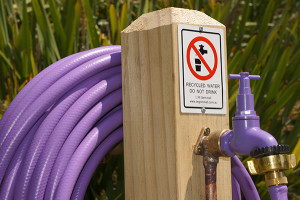 The treatment and use of recycled water are regulated by the California Department of Public Health to ensure adequate safety and monitoring. Recycled water must be transported through a system of pipes that is completely separate from potable water pipes. Recycled water pipes are painted purple and must be clearly labeled. Recycled water is acceptable for human contact, but not suitable for drinking, swimming pools, or baths.
The treatment and use of recycled water are regulated by the California Department of Public Health to ensure adequate safety and monitoring. Recycled water must be transported through a system of pipes that is completely separate from potable water pipes. Recycled water pipes are painted purple and must be clearly labeled. Recycled water is acceptable for human contact, but not suitable for drinking, swimming pools, or baths.
In our area, recycled water is produced by Palo Alto Regional Water Quality Control Plant, which exceeds most quality standards set by the state.
More info:
Recycled and other Non-potable water, City of Palo Alto
Recycled Water Treatment Process, Purple Pipe Company
2. Can I use recycled water on my plants and trees?
Yes, but with caution, and not for all species. Recycled water is a drought-proof source of water that saves potable water and can be valuable in the landscape as a supplemental source of water.
 However, it’s important to exercise caution; most recycled water has a high salt content that can harm many tree species and woody plants. Only a few tree species have a high tolerance for salt. Some species are extremely intolerant and can be killed by exclusive use of recycled water. Most trees are somewhere in between.
However, it’s important to exercise caution; most recycled water has a high salt content that can harm many tree species and woody plants. Only a few tree species have a high tolerance for salt. Some species are extremely intolerant and can be killed by exclusive use of recycled water. Most trees are somewhere in between.
To maintain healthy trees and landscapes, follow these recycled water guidelines:
More info:
The Salinity Management Guide (From Southern California Salinity Coalition and National Water Research Institute)
3. Where do I get recycled water?
In Palo Alto and surrounding communities, you can get recycled water from the Regional Water Quality Control Plant (RWQCP). There is no charge for the water itself, but permits are required to obtain and use recycled water to irrigate commercial or residential properties.
Additionally, local companies such as RainDance and Purple Pipe Water Services deliver recycled and ground water to residents. You can work with them to design the optimal application method and frequency to save both water and trees.
4. What is graywater? Is it safe for watering trees?
Gray water is potable water leftover from household use such as baths, showers, and washing machines. It does not technically include water from kitchens or toilets, since these sources may contain contaminants.
It is perfectly safe to use gray water to water your trees and plants, as long as you use biodegradable soaps and shampoos.
More info:
City of Palo Alto Laundry to Landscape Graywater Resources (PDF).
5. What about re-using water from construction sites?
In Palo Alto, the City (and some residents) have used “dewatering” water—groundwater pumped out from local basement construction sites—to water urban trees.
This water from dewatering stations is not as high in salinity as recycled water, but still higher in salinity than most potable water sources. If you choose to use dewatering water, treat it as a supplemental water source for your landscape by mixing or alternating it with potable water.
More info: City of Palo Alto FAQ on Dewatering water.
How-to Tree Watering Videos
More from Canopy:
Other great sources: